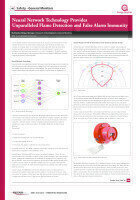Safety
Neural Network Technology Provides Unparalleled Flame Detection and False Alarm Immunity
Oct 30 2013
Author: Shankar Baliga, Manager, Research & Development, General Monitors on behalf of MSA - General Monitors
Loss of valuable equipment and inventory from the destruction of an undetected fire or the complete shutdown of an entire facility resulting from a false fire alarm are both costly scenarios no company wants to ever experience, particularly when there are preventative measures available to avoid such catastrophe. But deciding how best to protect your personnel, your facility and your investments is a critical consideration. This article addresses
the latest ground-breaking technology behind Multi-Spectral Infrared (MSIR) Flame Detection using Neural Network Technology (NNT).
Neural Network Technology
Neural networks are mathematical models that were inspired by biological neural networks. In artificial neural networks, an interconnected group of artificial neurons process information and actually change structure during a learning phase. That allows the network to model complex relationships in the data delivered by sensors in a quick search for patterns (Fig 1). Computer researchers have been inspired by the human brain as far back as the 1940s when a neuroscientist and a logician teamed up to create the first conceptual model of an artificial neural network to solve certain kinds of problems that are easy for humans but difficult for computers – otherwise known as pattern recognition. Neural networks have a range of standard uses, many of which are at work in the FL4000H MSIR Detector from General Monitors.
They include:
• Pattern recognition
• Signal processing that can filter out irrelevant data
• Controls that manage decisions
• Soft sensors that analyse a collection of many measurements
• Anomaly detection – the ability to generate output when something occurs that doesn’t fit patterns thus issuing alerts when something is amiss
Neural Network Technology (NNT) is in essence, an artificial intelligence. One of the key elements behind this technology is its ability to learn. It learns through a type of apperceptive process; meaning the comprehension or assimilation of something such as a new idea, can then be related in terms of previous experiences or perceptions. NNT operates similarly and is much like a human mind in the way that it enables a person to recognise a face from the distant past. For example, the brain facilitates recognition by matching a face with an image stored as a memory.
Just like a brain, the MSIR Flame Detector has thousands of pieces of data stored in its memory from hundreds of flame and non-flame patterns it has observed in the past. It has been trained to recognize a flame based upon that data, and make decisions about whether it is seeing an actual flame, even if it has not seen that exact pattern in the past.
Greater Range and Field of View Means Fewer Detectors and Cost Savings
General Monitors’ FL4000H MSIR Flame Detector combines a complex sensor array with highly intelligent neural network processors to provide new pattern recognition abilities; it has been trained to differentiate between real threats and normal events. MSIR technology allows area coverage up to six times greater than that of more conventional ultraviolet infrared (UV/IR) flame detectors. MSIR technology performs under various environmental conditions and offers faster response times and increased detection distances (Fig 2). Use of a four-sensor array enables the FL4000H MSIR to detect flame and non-flame events. The four sensors sample unique IR spectral wavelengths and convert those signals into a digital format to extract time and frequency data. Four sensors provide more data, increased detection distances, excellent immunity to false alarms, faster response times, and better
performance under various environmental conditions. The data acquired by the four sensors is automatically conveyed to the neural network where the real work of determining the threat level is done.
A longer range and wider field of view means fewer detectors can cover larger territory reducing the cost of protection. The FL4000H MSIR Detector reliably differentiates between real fire threats and common activities like random motion, modulation of heated surfaces, hot air flow, reflection off water surfaces, lightning, and arc welding, to name a few.
The FL4000H MSIR Flame Detector’s (Fig 3.) inherent differences lie in a unique marriage of a state-of-the-art artificial neural network and sophisticated sensor arrays. This flame detector can discover fire threats faster, and at greater distances, than any other product of its kind. Combine that with its superior false alarm immunity, and protection from both fire and false alarms is now possible. That can translate into substantial savings for growing industries like mid-stream oil, gas, and petroleum markets with compressor stations and processing plants as well as other large-scale manufacturing facilities.
Digital Edition
PIN 25.5 Oct/Nov 2024
November 2024
Analytical Instrumentation - Picturing Viscosity – How Can a Viscometer or a Rheometer Benefit You? - Sustainable Grease Formulations: Evaluating Key Performance Parameters and Testing Method...
View all digital editions
Events
Jan 20 2025 San Diego, CA, USA
Jan 22 2025 Tokyo, Japan
Jan 25 2025 San Diego, CA, USA
SPE Hydraulic Fracturing Technology Conference and Exhibition
Feb 04 2025 The Woodlands, TX, USA
Feb 05 2025 Guangzhou, China















